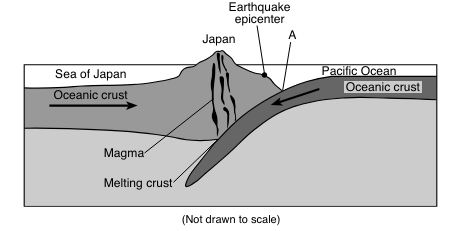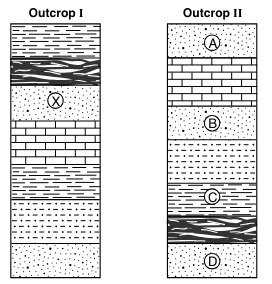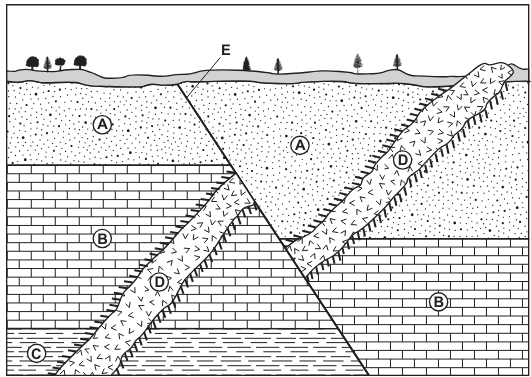An unknown substance is provided in a science class. Looking at the substance, a student observes different colors and different sizes of particles unevenly distributed throughout the substance. What type of substance is this?
a. solution
b. compound
c. heterogeneous mixture
d. homogeneous mixture
c. heterogeneous mixture
Fossil fuels were formed from
a. volcanoes
b. the remains of living things
c. gases in the atmosphere
d. water trapped inside rocks
b. the remains of living things
What type of tectonic plate boundary is represented in the cross section below?

Convergent
How are estuaries different from lakes or the ocean?
a. Estuaries contain only salt water
b. Estuaries contain only freshwater
c. Estuaries contain both salt water and freshwater
d. Estuaries are not bodies of water
c. Estuaries contain both salt water and freshwater
How is an epidemic different from a pandemic?
a. An epidemic involves a less serious disease.
b. An epidemic involves a smaller geographic area.
c. An epidemic refers to human diseases, and a pandemic refers to
nonhuman diseases.
d. An epidemic lasts for a longer time than a pandemic.
b. An epidemic involves a smaller geographic area.
Which organism in the food chain is a secondary consumer?

Frog
Sodium is an element found in table salt. It contains 11 protons and 12 neutrons. How many electrons are found in a neutral atom of sodium?
11
The burning of fossil fuels has increased the carbon dioxide content of the atmosphere. What is a possible effect that the increased amount of carbon dioxide is likely to have on our planet?
a. warmer climate
b. cooler climate
c. lower relative humidity
d. more ozone in the atmosphere
a. warmer climate
During which geologic era did humans first appear on Earth?
Cenozoic
What is a possible effect of high nutrient levels in water systems?
a. algal blooms
b. fewer algae
c. healthier fish
d. hotter water
a. algal blooms
Which describes one of the earliest (Traditional) forms of biotechnology?
a. splicing human genes into bacteria to produce insulin
b. selectively breeding dogs to create a new breed
c. producing a clone of a farm animal
d. determining the sequence of genes in DNA fingerprinting
b. selectively breeding dogs to create a new breed
Which of the following is an abiotic factor in an ecosystem?
a. bacteria
b. air
c. niche
d. grass
b. air
Which elements in the periodic table are least likely to combine with other elements?
a. halogens
b. noble gases
c. alkaline earth metals
d. transition metals
b. noble gases
Coal, Oil, Natural Gas and Nuclear Energy
Which rock layer in outcrop II best correlates with layer X in outcrop I?

Layer D
Which of the following are indicators of a healthy water source?
a. high nitrates, high pH, and low temperature
b. low temperature, high dissolved oxygen, and neutral pH
c. low pH, high nitrates, and low dissolved oxygen
d. high turbidity, high dissolved oxygen, and high temperature
b. low temperature, high dissolved oxygen, and neutral pH
In which process do cells take in carbon dioxide and use it to make food
molecules?
a. decomposition
b. meiosis
c. photosynthesis
d. respiration
c. photosynthesis
The cattle egret perches on a buffalo´s back and is carried from one location to another. The egret eats insects flushed from the grass as the buffalo moves. The buffalo is neither helped nor harmed. This is an example of what type of symbiotic relationship?
Commensalism
How do the properties of a compound compare to the properties of the elements that make it up?
a. The properties of the compound are the same as the elements that make it
b. The properties of the compound are different than the elements that make it
c. The properties of the compound may vary, while the properties of the elements that make it up do not change
d. The properties of the compound are teh same as the properties of only one of the elements that make it
b. The properties of the compound are different than the elements that make it
Why is it important to conserve energy even from renewable resources?
a. Renewable energy resources cannot be replaced after they are used.
b. Using renewable energy resources causes more pollution than using
nonrenewable resources.
c. Renewable energy resources produce radioactive wastes.
d. Every kind of renewable energy resource has some disadvantages.
d. Every kind of renewable energy resource has some disadvantages.
Which describes an index fossil?
a. It is found only in a small area.
b. It is fairly common in many places.
c. It is the fossil of a species that existed for a very long time.
d. It is difficult to identify.
b. It is fairly common in many places.
A clear example of point-source pollution is
a. trash floating in ocean water
b. runoff wastes in a river
c. oil spilling from a supertanker
d. salts from irrigation
c. oil spilling from a supertanker
Which diseases can be treated with antibiotics?
a. virus-caused diseases, such as polio and measles
b. fungus-caused diseases, such as warts and yeast infections
c. noninfectious diseases, such as diabetes and heart disease
d. bacterial diseases, such as food poisoning and pneumonia
d. bacterial diseases, such as food poisoning and pneumonia
How much of the energy from one trophic level is transferred to the next?
a. None of the energy is transferred
b. About 1% of the energy is transferred
c. About 10% of the energy is transferred
d. All of the energy is transferred
c. About 10% of the energy is transferred
Name 3 ways you can tell a chemical change has occurred?
1. Precipitate forms
2. Fire (combustibility/flammability)
3. Rusting (Oxidation)
4. Unexpected temperature, color, odor, bubbling change
Which is an advantage of using nuclear power plants?
a. They use renewable energy resources.
b. They do not cause air pollution.
c. They change radioactive substances into harmless substances.
d. They produce unlimited electrical energy.
b. They do not cause air pollution.
Put the layers and events in order from oldest to youngest.

Oldest: C, B, A, D, E :Youngest
Under which conditions are large numbers of fish in a lake most likely to die?
a. right after a storm with heavy rainfall
b. when the water´s dissolved oxygen is high and temperatures are lower than average
c. when the water´s dissolved oxygen is low and temperatures are higher than average
d. when the water´s turbidty is low and the temperatures are in the average range
c. when the water´s dissolved oxygen is low and temperatures are higher than average
Which describes digestion in the human body?
a. a process that breaks down food into smaller molecules that cells
can use
b. a process that releases energy from food molecules
c. a process that delivers oxygen throughout the body
d. a process by which the body gets rid of wastes
a. a process that breaks down food into smaller molecules that cells
can use
Which of these is one role of plants in the carbon cycle?
a. Plants take in oxygen and release carbon dioxide
b. Plants take in carbon dioxide and pass it on directly to animals
c. Plants take in carbon dioxide released by other organisms
d. Plants use carbon dioxide to make nitrates
c. Plants take in carbon dioxide released by other organisms